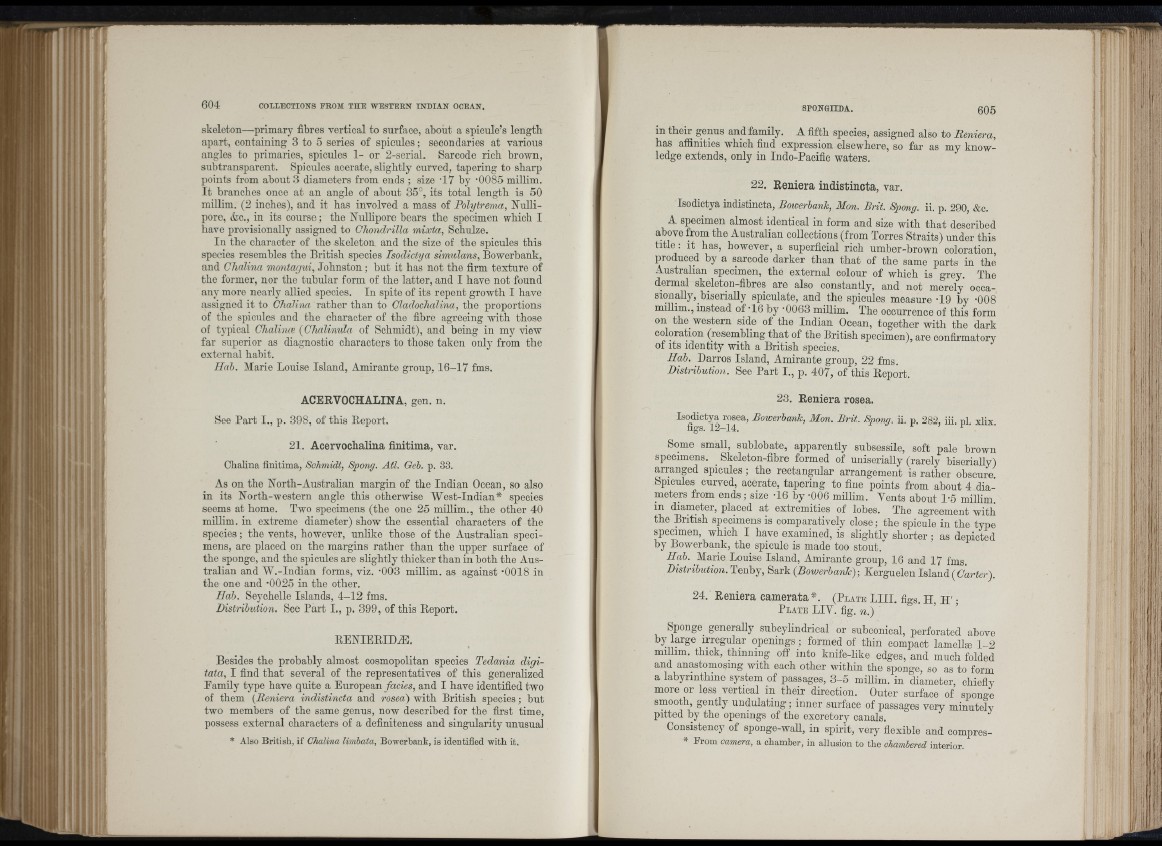
skeleton—primary fibres vertical to surface, about a spieule’s length
apart, containing 3 to 5 series of spicules; secondaries at various
angles to primaries, spicules 1- or 2-serial. Sarcode rich brown,
sub transparent. Spicules acerate, slightly curved, tapering to sharp
points from about 3 diameters from ends ; size -17 by -0085 millim.
I t branches once a t an angle of about 35°, its total length is 50
millim. (2 inches), and it bas involved a mass of Polytrema, Nulli-
pore, ifec., in its course; tbe Niillipore bears the specimen wbicb I
bave provisionally assigned to Chondrilla mixta, Schulze.
In the character of tbe skeleton and the size of the spicules this
species resembles the British species Isodictya simulans, Bowerbank,
and Chalina montagui, Johnston; but it bas not the firm texture of
tbe former, nor tbe tubular form of the latter, and I bave not found
any more nearly allied species. In spite of its repent growth I have
assigned it to Chalina rather than to Cladochalina, tbe proportions
of the spicules and the character of tbe fibre agreeing with those
of typical Chalince (Chcdinula of Schmidt), and being in my view
far superior as diagnostic characters to those taken ouly from the
external habit.
Hah. Marie Louise Island, Amirante group, 16-17 fms.
i i
E i
ACERVOCHALINA, gen. n.
See Part I., p. 398, of tbis Peport.
21. Acervocbalina finitima, var.
Chalina finitima, Schmidt, Spong. Atl. Geh. p. 33.
As on the North-Austrahan margin of tbe Indian Ocean, so also
in its North-western angle this otherwise West-Indian* species
seems at bome. Two specimens (tbe one 25 millim., tbe otber 40
millim. in extreme diameter) show tbe essential characters of tbe
species; the vents, however, unlike those of tbe Australian specimens,
are placed on the margins rather than tbe upper surface of
tbe sponge, and tbe spicules are slightly thicker than in botb tbe Australian
and AV.-Indian forms, viz. -003 mPlim. as against -0018 in
tbe one and ’0025 in tbe other.
Hab. Seychelle Islands, 4-12 fms.
Distribution. See Part I., p. 399, of tbis Report.
R E N IE R ID ^ .
Besides the probably almost cosmopolitan species Tedania digitata,
I find th at several of tbe representatives of tbis generalized
Family type bave quite a European facies, and I bave identified two
of them {Reniera indistincta and rosea) with British species; but
two members of the same genus, now described for tbe first time,
possess external characters of a definiteness and singularity unusual
* Also British, if Chalina limbata, Bowerbank, is identified with it.
m tbeir genus and family. A fifth species, assigned also to Reniera,
has affinities which find expression elsewhere, so far as my knowledge
extends, only in Indo-Pacific waters.
22. Reniera indistincta, var.
Isodictya indistincta, Bowerbank, Mon. Brit. Spong. ii. p. 290, &c.
A specimen almost identical in form and size witb th a t described
above from tbe Australian collections (from Torres Straits) under this
title : it has, however, a superficial rich umber-brown coloration,
produced by a sarcode darker than th a t of tbe same parts in tbe
Australian specimen, the external colour of wbicb is grey. Tbe
dermal skeleton-fibres are also constantly, and not merely occasionally,
biserially spiculate, and the spicules measure -19 by -008
miUim., instead of -16 by -0063 millim. Tbe occurrence of tbis form
on tbe western side of tbe Indian Ocean, together witb tbe dark
coloration (resembling th at of tbe British specimen), are confirmatory
of its identity with a British species.
Hab. Darros Island, Amirante group, 22 fms.
Distrihution. See P a rt I., p. 407, of tbis Report.
23. Reniera rosea.
Isodictya rosea, Bowerbank, Mon. Brit. Spong. ii. p. 282 iii nl xlix
figs. 12-14. J • R •
Some small, sublobate, apparently subsessile, soft pale brown
specimens. _ Skeleton-fibre formed of uniserially (rarely biserially)
arranged spicules ; tbe rectangular arrangement is ratber obscure
Spicules curved, acerate, tapering to fine points from about 4 diameters
from en d s; size -16 by -006 miPim. Vents about 1-5 millim.
in diameter, placed at extremities of lobes. Tbe agreement with
the British specimens is comparatively close; tbe spicule in tbe type
specimen, which I bave examined, is sligbtlv sh o rte r; as depicted
by Bowerbank, tbe spicule is made too stout.
Hab. Marie Louise Island, Amirante group, 16 and 17 fms
Distribution. Tenby, Sark {Bowerbank); Kerguelen Island (Narier).
24. Reniera camerata *. ( P l a t e L III. figs H H' •
P l a t e LIV. fig. n.) ' ’ >
Sponge generally subcylindrical or suhconical, perforated above
by large irregular openings ; formed of thin compact lamellm 1-2
millim. thick, thinning off into knife-like edges, and mucb folded
and anastomosing with each otber within the sponge, so as to form
a labyrinthine system of passages, 3 -5 millim. in diameter, cbiefly
more or less vertical in their direction. Outer surface of sponge
smooth, gently undulating; inner surface of passages very minutely
pitted by tbe openings of tbe excretory canals.
Consistency of sponge-waU, in spirit, very flexible and compres-
From camera, a chamber, in allusion to the chambered interior.
I 5